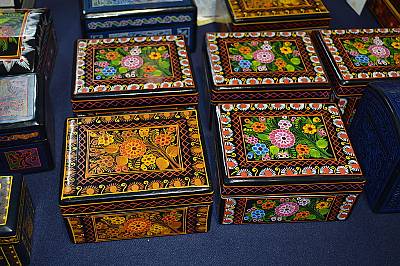- Mexico


Olinalá Lacquerware in Mexico

© “ExpoIndigenous2015 036” by AlejandroLinaresGarcia is licensed under CC BY-SA 4.0
1. ICH domains
Traditional craftsmanship
2. Short description
Olinalá lacquerware is of pre-Hispanic origin and considered one of the most important artisan traditions in the state of Guerrero, Mexico.
Using wood from linalóe, a native Mexican tree species (Bursera linanoe), various objects such as fruit or bread baskets, jewellery boxes, pens and furniture are produced and ornamented by hand. The elaboration of these objects takes time and is traditionally carried out using natural elements, such as limestone, soils, natural dyes and oils (e.g. chia).
The artisanal production of Olinalá lacquerware is internationally recognized. Some of the most able craftspersons have received awards and recognitions, such as the Great Masters of Mexican Folk Art.
Further information:
The following links provide further information (in Spanish):
https://www.youtube.com/watch?v=SdDkX0P070o
https://www.youtube.com/watch?v=kCZw5Qln2Q0
More information (in English) on Olinalá lacquerware can be found at:
https://www.mexican-folk-art-guide.com/mexican-lacquerware.html#.W6jgeHszbGg
A link on the reforestation of the linalóe tree (in Spanish):
http://www.20minutos.com.mx/noticia/236503/0/militares-trabajan-para-rescatar-el-linaloe-materia-prima-de-las-cajas-de-olinala/
3. Link with sustainable development
Currently, the commercialization of lacquerware handicrafts generates income for approximately 10,000 Olinalá families, or about 70 to 80 per cent of the total population. This tradition thus represents the main source of income for this population, garnered both from the sale of traditional products and from related local tourism, providing a clear example of how intangible cultural heritage can bring economic benefits to its bearers. Since 2014, the entire marketing process has been based on a management and conservation strategy of the linalóe tree, the main raw material used in the production of this handicraft. Through the replanting of linalóe trees to maintain local production, the population has become increasingly aware of the need for more sustainable patterns of production and consumption. This example thus demonstrates SDG 8 on promoting inclusive and sustainable economic growth, employment and decent work for all and SDG 12, on ensuring sustainable consumption and production patterns.
4. Questions for reflection
Despite the commercial success of Olinalá lacquerware, there is a trend of aging artisans and low attraction among youth. The new generations consider the prices paid to the craftsmen by intermediary commercialization agents to be too little. Young people have thus opted for other occupations, and many migrate abroad in search of more lucrative opportunities than this traditional local production.
What can be done to attract young people to take up lacquerware making, and thereby ensure the visibility of this craftsmanship?
Do you know of other examples where transmission of craftsmanship is threatened? What is being being done in those situations?